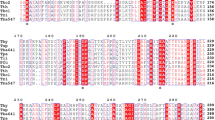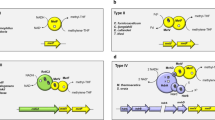Abstract
In vivo hydrogen production in Clostridium acetobutylicum involves electron transfer between ferredoxin and [FeFe]-hydrogenase. Five C. acetobutylicum open reading frames were annotated as coding for putative ferredoxins. We focused our biophysical and biochemical investigations on CAC0303 and CAC3527, which possess the sequence signature and length of classical 2[4Fe4S] clostridial ferredoxins but differ significantly in theoretical pI. After cloning, heterologous expression in E. coli followed by in vitro Fe-S incorporation and purification, CAC0303 was shown to have a regular electron paramagnetic resonance (EPR) signal for a classical 2[4Fe4S] clostridial ferredoxin, while CAC3527 displayed an unusual EPR signal and a quite low reduction potential. Both ferredoxins were reduced in vitro by C. acetobutylicum [FeFe]-hydrogenase, but the CAC3527 reduction rate was 10-fold lower than that of CAC0303. These results are consistent with the efficiency of intermolecular electron transfer being dictated by the redox thermodynamics, the contribution of the ferredoxin global charge being only minor. The physiological function of CAC3527 is discussed.




Similar content being viewed by others
References
Armstrong FA, Camba R, Heering HA, et al. (2001) Fast voltammetric studies of the kinetics and energetics of coupled electron-transfer reactions in proteins. Faraday Disc 116:191–204
Asso M, Mbarki O, Guigliarelli B, et al. (1995) EPR and redox characterization of ferredoxins I and II from Desulfovibrio vulgaris Miyazaki. Biochem Biophys Res Commun 211:198–204
Bradford MM (1976) A rapid and sensitive method for the quantification of micrograms quantities of protein utilizing the principle of protein-dye binding. Anal Biochem 72:248–254
Chen JS, Blanchard DK (1979) A simple hydrogenase-linked assay for ferredoxin and flavodoxin. Anal Biochem 93:216–222
Demuez M, Cournac L, Guerrini O, Soucaille P, Girbal L (2007) Complete activity profile of Clostridium acetobutylicum [FeFe]-hydrogenase and kinetic parameters for endogenous redox partners. FEMS Microbiol Lett 275:113–121
Duff JLC, Breton JLJ, Butt JN, et al. (1996) Novel redox chemistry of [3Fe-4S] clusters: electrochemical characterization of the all-Fe(II) form of the [3Fe-4S] cluster generated reversibly in various proteins and its spectroscopic investigation in Sulfolobus acidocaldarius ferredoxin. J Am Chem Soc 118:8593–8603
Feinberg BA, Lo X, Iwamoto T, et al. (1997) Synthetic mutants of Clostridium pasteurianum ferredoxin: open iron sites and testing carboxylate coordination. Protein Eng 10:69–75
Girbal L, Von Abendroth G, Winkler M, et al. (2005) Homologous/heterologous over–expression in Clostridium acetobutylicum and characterization of purified clostridial and algal Fe–only hydrogenases with high specific activity. Appl Environ Microbiol 71:2777–2781
King PW, Posewitz MC, Ghirardi ML, et al. (2006) Functional studies of [FeFe] hydrogenase maturation in an Escherichia coli biosynthetic system. J Bacteriol 188:2163–2172
Kutty R, Bennett GN (2007) Characterization of a novel ferredoxin with N-terminal extension from Clostridium acetobutylicum ATCC 824. Arch Microbiol 187:161–169
Kyritsis P, Hatzfeld OM, Link TA, et al. (1998) The two [4Fe-4S] clusters in Chromatium vinosum ferredoxin have largely different reduction potentials. J Biol Chem 273:15404–15411
Kyristsis P, Kümmerle R, Gaspard Huber J, et al. (1999) Unusual NMR, EPR, and Mossbauer properties of Chromatium vinosum 2[4Fe-4S] ferredoxin. Biochemistry 38:6335–6345
Laviron E (1979) General expression of the linear potential sweep voltammogram in the case of diffusionless electrochemical systems. Electroanal J Chem 101:19–28
Léger C, Dementin S, Bertrand P, et al. (2004) Inhibition and aerobic inactivation kinetics of Desulfovibrio fructosovorans NiFe hydrogenase studied by protein film voltammetry. J Am Chem Soc 126:12162–12172
More C, Camensuli P, Dole F, et al. (1996) A new approach for the structural study of metalloproteins: the quantitative analysis of intercenter magnetic interactions. J Biol Inorg Chem 2:152–161
Moulis JM, Davasse V (1995) Probing the role of electrostatic forces in the interaction of Clostridium pasteurianum ferredoxin with its redox partners. Biochemistry 34:16781–16788
Moulis JM, Meyer J (1982) Characterization of the selenium substituted 2[4Fe-4Se] ferredoxin from Clostridium pasteurianum. Biochemistry 21:4762–4771
Nölling J, Breton G, Omelchenko MV, et al. (2001) Genome sequence and comparative analysis of the solvent producing bacterium Clostridium acetobutylicum. J Bacteriol 183:4823–4838
Quinkal I, Davasse V, Gaillard J, et al. (1994) On the role of conserved proline residues in the structure and function of Clostridium pasteurianum 2[4Fe-4S] ferredoxin. Protein Eng 7:681–687
Soni BK, Soucaille P, Goma G (1987) Continuous acetone butanol fermentation: influence of vitamins on the metabolic activity of Clostridium acetobutylicum. Appl Microbiol Biotechnol 2:1–5
Vasconcelos I, Girbal L, Soucaille P (1994) Regulation of carbon and electron flow in Clostridium acetobutylicum grown in chemostat culture at neutral pH on mixtures of glucose and glycerol. J Bacteriol 176:1443–1450
Vignais PM, Billoud B, Meyer J (2001) Classification and phylogeny of hydrogenases. FEMS Microbiol Rev 25:455–501
Acknowledgments
O.G. was the recipient of a doctoral fellowship from the Centre National de la Recherche Scientifique and the Agence de l’Environnement et de la Maîtrise de l’Energie.
Author information
Authors and Affiliations
Corresponding author
Rights and permissions
About this article
Cite this article
Guerrini, O., Burlat, B., Léger, C. et al. Characterization of Two 2[4Fe4S] Ferredoxins from Clostridium acetobutylicum . Curr Microbiol 56, 261–267 (2008). https://doi.org/10.1007/s00284-007-9072-x
Received:
Accepted:
Published:
Issue Date:
DOI: https://doi.org/10.1007/s00284-007-9072-x




